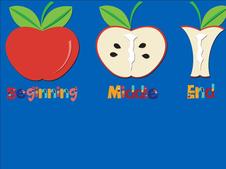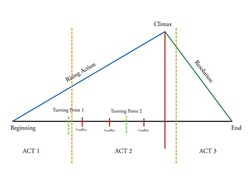
All stories follow a three-part structure: the beginning, middle, and the end. That may seem simple, but they each part requires different elements of the story at different times in order for it to work right. When this is done well in a book or a movie you, the audience, don’t even notice. But when something is out of place, it just feels wrong, and the whole story is uncomfortable or even objectionable.
There are several ways to explain these three parts:
1. Beginning - setup.
All man characters and their situation are explained and a problem is introduced, which spurs the story on.
2. Middle – conflict.
The bulk of the story, starting with an inciting incident, or catalyst, that begins the character on a quest for something. This is where characters face the majority of their struggles and develop as a result, called the character arc.
3. End – resolution.
The problem, conflict, and struggle all come to a boiling point and explode. The characters are forced to deal with it and make choices how to overcome and move on.
Another way to describe it:
1. Beginning – character gets lost.
2. Middle - character struggles to find their way.
3. End – character reaches a conclusion, either finding their way and getting what they want, or failing.
Or…
1. Beginning – background and inciting incident and outcome of experiencing that.
2. Middle – escalation of conflict and struggle.
3. End – climactic conclusion, and ease down.

It can be further broken down because along the way there are a handful of“Tent Pole Moments” that hold up the story. They are high points where we check in with the character and revisit the structure of their basic quest, so we know the story is on track. Think of them as big mile markers in a marathon, where we can clearly track emotional growth/change/learning of the main character.
Those mile markers are sometimes described in eight parts. Note: do not write INTO those eight parts or it will be too formulaic, write your story and THEN lay the translucent map of these eight points over your story to see how well it’s structured, and make changes as needed or to divert it back on track:
- Stasis
- Trigger
- The quest
- Surprise
- Critical choice
- Climax
- Reversal
- Resolution
Stasis
A description of the everyday life and the world in which the story will take place.
Trigger
Something major happens to the main character spark the story.
The Quest
The trigger results in a quest. It could be a quest to return to status quo because something bad happened or was taken away, or a quest for some great and wonderful achievement, or a quest for inner happiness, etc.
Surprise
This takes up most of Part 2 – the middle of the story, and holds the series of struggles, disappointments, obstacles, and derailments from that quest. These obstacles shouldn’t be too predictable nor too random. A reader should feel something is coming, but then be surprised by how/what happens.
Critical choice
Throughout the Middle the tension rises until something has to give, and the story explodes from the pressure. As that build up occurs, the main character scrambles around to keep up and stay on their quest, but eventually they are overwhelmed and need to make a critical choice. They have to decide what actions to take in the midst of that out of control rock bottom explosion, and that choice reveals more about their character and personality and desire than anything else in the book. It doesn’t have to be perfect – just authentic.
Climax
Due to the critical choice the character made, all of the conflict and struggle from the quest comes to a climax. This is the peak of tension in the story.
Reversal
The character has made their choice and the story has already exploded, and now we see how it all falls to earth. Something happens because of that choice, and this shows the emotional growth and change in the main character. The story reversal needs to be inevitable and probable.
Resolution
The resolution (also called dénouement) is just the wind-down into normal, regular life again, but a new statis that is different than before because of everything that has happened and how the character changed.

Think of your story as a stew of ingredients that you want to stir every once and a while to keep them from burning.
So as you write, mix up (in order of priority):
1) Action
2) Dialogue (including inner dialogue)
3) Narrative
For instance, if you have a long portion of dialogue, have the characters take off their coat and sit down in the middle (example) to break it up with some action. Or if you’re going through a portion of narrative when you (the omniscient writer) are thinking about your life and explaining, break it up with a line of dialogue from someone around you.
What else?
-Mix between scene and summary – like a movie camera zooms in and slows down, but then pans out and shows the big picture.
-Control the pace of your story.
-Keep building tension.
-Sprinkle it with flashbacks to connect us with the touchstone of the character’s essentials.
***
I hope that helps! Put the right ingredients into the pot at the right time and keep stirring the stew and your writing will feel well balanced and keep moving for the reader, and never burn!
Happy writing, and drop me an email to say hi and tell me about your story!
Norm :-)
 RSS Feed
RSS Feed